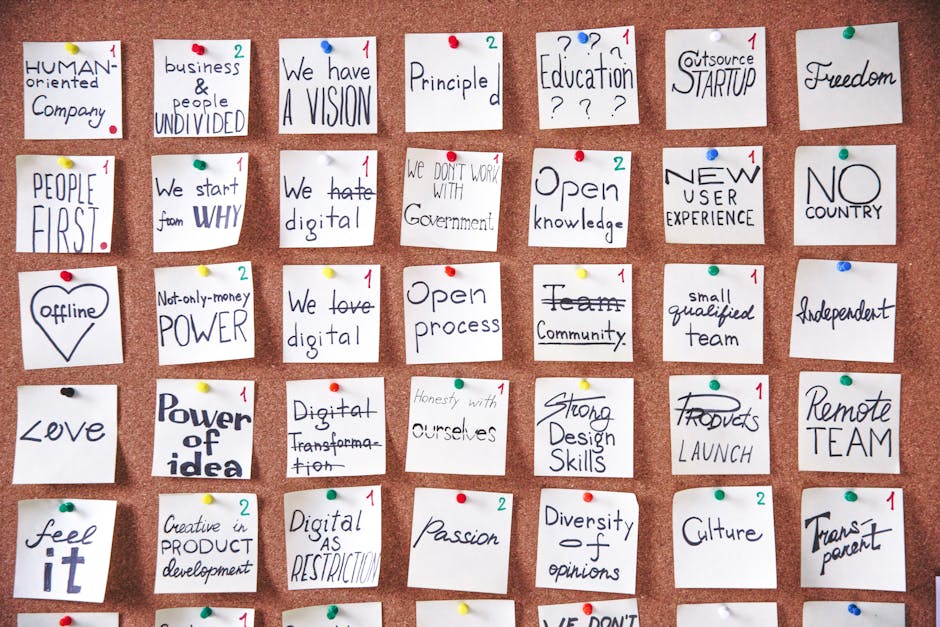Yorkshire’s Ultimate Guide To MVP Software For Start-ups
Welcome to Yorkshire’s Ultimate Guide to MVP Software for Start-ups! We will take you on a journey through the vibrant and innovative world of Minimum Viable Product (MVP) development.
Just like the picturesque landscapes of Yorkshire, MVP software acts as a window into the potential success of your start-up.
Think of MVP software as the first brushstrokes on a masterpiece canvas, allowing you to test your ideas, gather feedback, and make informed decisions before fully committing. It serves as a powerful tool that empowers start-ups to launch their products or services efficiently while minimising risks and maximising customer satisfaction.
In this comprehensive guide, we will explore how to define your MVP goals and objectives, identify your target audience and market, choose the right tools and technologies for building your MVP, test and iterate for success, and ultimately scale up your start-up using this agile approach.
So grab a cuppa tea and get ready to embark on an enlightening journey towards creating successful start-ups with MVP software in Yorkshire!
Key Takeaways
- MVP software allows start-ups to test their ideas and gather feedback before fully committing, minimising risks and maximising customer satisfaction.
- User feedback is essential in MVP development as it helps shape the product roadmap and increase the chances of success.
- Setting realistic expectations and measuring important metrics such as user engagement and conversion rates are crucial in defining MVP goals and determining success.
- Building an MVP requires selecting the right programing language, leveraging cloud-based services, and utilising agile methodologies and rapid prototyping tools for efficient development and testing.
Understanding MVP Software and its Benefits for Start-ups

So you’re starting a new start-up and wondering how MVP software can benefit you? Well, let me tell you, using MVP software will not only save you time and money but also allow you to quickly test your product in the market and gather valuable feedback from users. The importance of user feedback in MVP development cannot be overstated. By releasing a minimal version of your product, you can gauge user response and make necessary improvements before investing more resources into full-scale development.
One of the common pitfalls to avoid when implementing MVP software for start-ups is falling into the trap of overbuilding. It’s easy to get carried away with adding features that are not essential for the initial release. However, this can lead to unnecessary delays and increased costs. Instead, focus on building the core functionality that solves a specific problem for your target audience.
Another pitfall is neglecting user feedback during the MVP stage. This valuable input can provide insights into what users truly need and want from your product. Actively seek out feedback through surveys, interviews, or beta testing programmes. Incorporating user suggestions early on will help shape your product roadmap and increase its chances of success.
Utilising MVP software allows start-ups to iterate quickly while saving time and money. By embracing user feedback throughout the process, you can refine your product based on real-world insights and avoid costly mistakes down the line.
Now that we understand the benefits of MVP software for start-ups, let’s move on to defining our MVP goals and objectives without delay. Let’s move on to defining our MVP goals and objectives without delay in order to prioritise the most essential features and functionalities that will deliver value to our users and validate our product concept.
Defining Your MVP Goals and Objectives

To truly hit the ground running with your MVP, it’s essential to clearly define your goals and objectives as the guiding compass for your start-up journey. Setting realistic expectations is crucial when defining your MVP goals. Understand that an MVP is not meant to be a final product but rather a starting point to gather feedback and validate your ideas. By setting realistic expectations, you can avoid disappointment and focus on the key features that will help you test and learn from your target audience.
Measuring MVP success should also be a part of your goal-setting process. Determine what metrics are most important for evaluating the performance of your MVP. These could include user engagement, conversion rates, or customer satisfaction levels. By establishing measurable goals, you can track progress and make informed decisions about whether to pivot or persevere with your product.
In addition to setting clear goals and measuring success, consider these additional factors:
- Identify key performance indicators (KPIs) that aline with your business objectives.
- Set specific targets for each KPI and regularly review them.
- Implement analytics tools to gather data on user behaviour and engagement.
- Continuously refine and iterate based on the feedback received.
By following these steps, you can ensure that you have a solid foundation for launching your MVP successfully.
Next, we will explore how identifying your target audience and market will play a vital role in shaping your product offering without compromising its unique value proposition.
Identifying Your Target Audience and Market

Understand who your target audience is and how they fit into the market in order to effectively shape your product offering. Customer segmentation and market research are essential components of this process.
Customer segmentation involves dividing your target audience into distinct groups based on shared characteristics, such as demographics, behaviours, or preferences. By identifying these segments, you can tailor your marketing efforts and product development to better meet their specific needs.
Market research goes hand in hand with customer segmentation by providing valuable insights into the overall market landscape. It helps you understand industry trends, competitors, and potential opportunities for growth. Through thorough research, you can uncover consumer pain points, identify gaps in the market, and discover untapped niches where your product can thrive.
By understanding your target audience and the broader market context, you can make informed decisions about how to position your MVP software for maximum impact. You’ll be able to craft a compelling value proposition that resonates with customers, differentiate yourself from competitors, and prioritise features that matter most to your target audience.
Now armed with this knowledge, it’s time to dive into building your MVP – tools and technologies. By leveraging the right tools and technologies in the development process, you can streamline workflows, improve efficiency, and create a robust foundation for future iterations of your product.
(Note: In this section, we will explore various tools and technologies that will empower you to build an effective MVP.)
Building Your MVP – Tools and Technologies

Ready to build your MVP? Let’s explore the essential tools and technologies that will empower you to create a powerful and efficient minimum viable product.
When it comes to MVP software development process, there are several best practises and tips that can help you streamline your workflow and ensure success.
Firstly, selecting the right programing language is crucial for building your MVP. Depending on your project requirements and team expertise, popular choices include Python, Ruby on Rails, or JavaScript frameworks like React or Angular. These languages offer flexibility and a wide range of libraries and resources that can accelerate development.
Next, employing cloud-based services such as Amazon Web Services or Microsoft Azure can significantly enhance your MVP’s scalability and reliability. These platforms provide easy access to computing power, storage solutions, and other infrastructure resources without the need for costly physical servers.
Using agile methodologies like Scrum or Kanban is another important aspect of building an MVP effectively. The iterative nature of these approaches allows for continuous improvement while ensuring transparency and collaboration amongst team members.
Additionally, leveraging rapid prototyping tools like InVision or Marvel can help you quickly visualise your ideas and gather valuable feedback from potential users before investing significant time in coding.
Lastly, integrating automated testing frameworks such as Selenium or Jest into your development process will save time by detecting bugs early on. This ensures a smoother user experience when testing the functionality of your MVP.
With these best practises and tips in mind, you’re well-equipped to start building an impactful MVP using the right tools and technologies.
Next up: testing and iterating your MVP for success by gathering user feedback and refining its features for optimal performance without compromising quality.
Testing and Iterating Your MVP for Success

Now it’s time for you to put your MVP to the test by gathering user feedback and refining its features for optimal performance without compromising quality.
Testing and iterating your MVP is a crucial step in the development process as it allows you to measure metrics and gather feedback to make informed decisions about future enhancements.
One of the key aspects of testing your MVP is measuring metrics. This involves tracking various data points such as user engagement, conversion rates, and customer satisfaction. By analysing these metrics, you can gain valuable insights into how users are interacting with your product and identify areas that need improvement. Whether it’s through A/B testing or user analytics tools, measuring metrics helps you make data-driven decisions for enhancing your MVP.
In addition to measuring metrics, gathering feedback from users is equally important. Actively seeking input from your target audience enables you to understand their needs, pain points, and preferences better. This can be done through surveys, interviews, or even beta testing programmes where users can provide direct feedback on their experience with your MVP.
By continuously iterating based on user feedback and metric analysis, you can refine your MVP’s features for optimal performance. This iterative process ensures that you are building a product that meets the needs of your target market while maintaining high-quality standards.
As you refine and improve your MVP based on user feedback and metric analysis, you’ll be well-prepared for scaling and growing your start-up with MVP software.
Scaling and Growing Your Start-up with MVP Software

Scaling and growing your start-up with MVP software is like watching a tiny seedling grow into a flourishing tree, as it allows you to expand your user base and develop new features based on real-world feedback. As your start-up gains traction, you will inevitably face scaling challenges. However, with the right MVP software, these challenges can be addressed effectively.
Here are some key considerations for scaling and growing your start-up:
-
Infrastructure scalability: Ensure that your MVP software is built on a scalable infrastructure that can handle increasing user demand. This may involve using cloud-based services or implementing load balancing techniques to distribute traffic efficiently.
-
User acquisition: With an MVP in hand, focus on acquiring new customers while maintaining existing ones. Leverage digital marketing strategies such as content marketing, social media advertising, and search engine optimisation to attract potential users to your platform.
-
Customer retention: Retaining customers is equally important as acquiring new ones. Implement features in your MVP software that enhance customer experience and provide value over time. This could include personalised recommendations, loyalty programmes, or seamless integration with other platforms.
-
Feedback loop optimisation: Continuously gather feedback from users and iterate on your MVP software accordingly. By understanding their pain points and desires, you can prioritise feature development and improve user satisfaction.
Successfully scaling and growing a start-up requires addressing the unique challenges that come with increased customer acquisition. By leveraging the power of MVP software, you can optimise infrastructure scalability, implement effective user acquisition strategies, prioritise customer retention efforts, and continuously iterate based on real-world feedback. Keep nurturing your seedling of an idea with the help of an impactful MVP software solution to witness significant growth in no time.
Frequently Asked Questions
What are the common challenges faced by start-ups when building an MVP?
Common challenges faced by start-ups when building an MVP include limited resources, time constraints, technical difficulties, and market validation. Strategies for success involve prioritising features, leveraging existing technologies, iterating quickly, and gathering user feedback.
How can start-ups effectively gather user feedback during the testing phase of their MVP?
To effectively gather user feedback during the testing phase of your MVP, conduct user testing sessions where you observe and record users’ interactions. Use surveys or interviews to gather their thoughts and suggestions for improvement.
What are some key factors to consider when choosing the right tools and technologies for building an MVP?
Key considerations for MVP software selection include compatibility with your development stack, scalability options, ease of integration with other tools, cost-effectiveness, and the level of support provided. Choosing the right tools ensures a smooth and efficient development process.
How can start-ups ensure the scalability and flexibility of their MVP as their user base grows?
As your user base grows, you’ll face scaling challenges. It’s ironic how success can bring its own set of problems! To ensure scalability and flexibility, employ strategies like cloud computing and modular architecture.
Are there any success stories of start-ups that have utilised MVP software to achieve significant growth?
Success stories of start-ups that have utilised MVP software are abundant. By following best practises and conducting case studies, these start-ups have achieved significant growth and reaped the benefits of a scalable and flexible product.
Conclusion
In conclusion, MVP software is an essential tool for start-ups looking to quickly validate their ideas and gain traction in the market. By defining clear goals and objectives, identifying target audience, and using the right tools and technologies, entrepreneurs can build a solid foundation for success.
Testing and iterating the MVP is crucial for refining the product and ensuring its viability. Interestingly, studies have shown that start-ups who use MVP software are 35% more likely to secure funding, painting a vivid picture of how this approach can greatly increase a start-up’s chances of success.
Contact us to discuss our services now!
